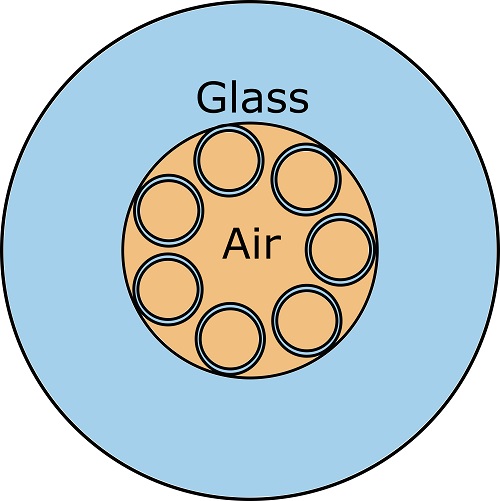ROCHESTER, N.Y., Sept. 22, 2020 — A hollow optical fiber developed by researchers at the University of Central Florida greatly reduces noise that interferes with transmitted signals, compared to single-mode fibers that are currently used to reduce noise. Researchers at the University of Rochester reported the development.
The antiresonant hollow-core fiber, created by researchers at the University of Central Florida (UCF), produces a thousand times less noise — and the lowest levels ever recorded from interference caused by acoustic phonons arising from the glass in the fiber at room temperatures.
Noise caused by phonons can be reduced by cooling fibers to extremely low cryogenic temperatures. That method, however, is both expensive and complicated, said William Renninger, assistant professor of optics at the University of Rochester.

The antiresonant hollow core fiber features a unique arrangement of seven hollow capillaries arranged around a hollow core inside the fiber. Courtesy of Arjun Iyer, University of Rochester.
The fiber developed by UCF represents a more straightforward technique that works at room temperature. Developed by Rodrigo Amezcua Correa and researchers at CREOL, the College of Optics and Photonics at the University of Central Florida, the fiber features a unique arrangement of seven hollow capillaries arranged around a hollow core inside the fiber.
The designs allows for minimal overlap between the fiber’s outer layer of glass and the light traveling through the core, thereby eliminating interference from acoustic phonons emanating from the glass.
To evaluate the fiber developed by UCF, researchers in Renninger’s lab developed a highly sensitive measuring technique.
“It’s a very valuable fiber, and despite a lot of interest in it by researchers and some companies, nobody had really studied the behavior of phonons supported by the structure, and to what extent it actually reduced ‘noise,’” Renninger said.
Tests by Renninger’s team showed that the arrangement is 10× more effective at reducing noise than other hollow-fiber designs.
“The little noise that’s left is caused by acoustic waves in the air inside the fiber, so if you were to evacuate the air, it would be another 100× more effective,” Renninger said. “You would have incredibly low noise.”
“The lab’s findings demonstrate that the fiber is viable option for low-noise applications, such as for quantum information processing and optical communications,” said Arjun Iyer, lead author of the research introducing the fiber.
The research was published in APL Photonics (www.doi.org/10.1063/5.0017796).